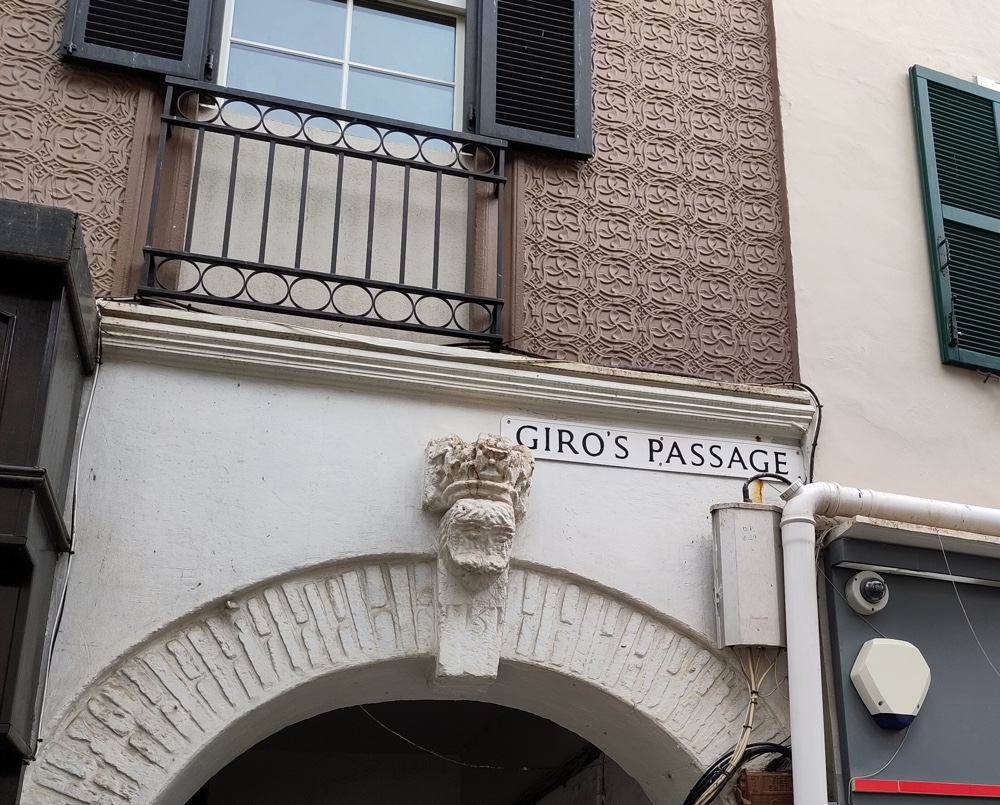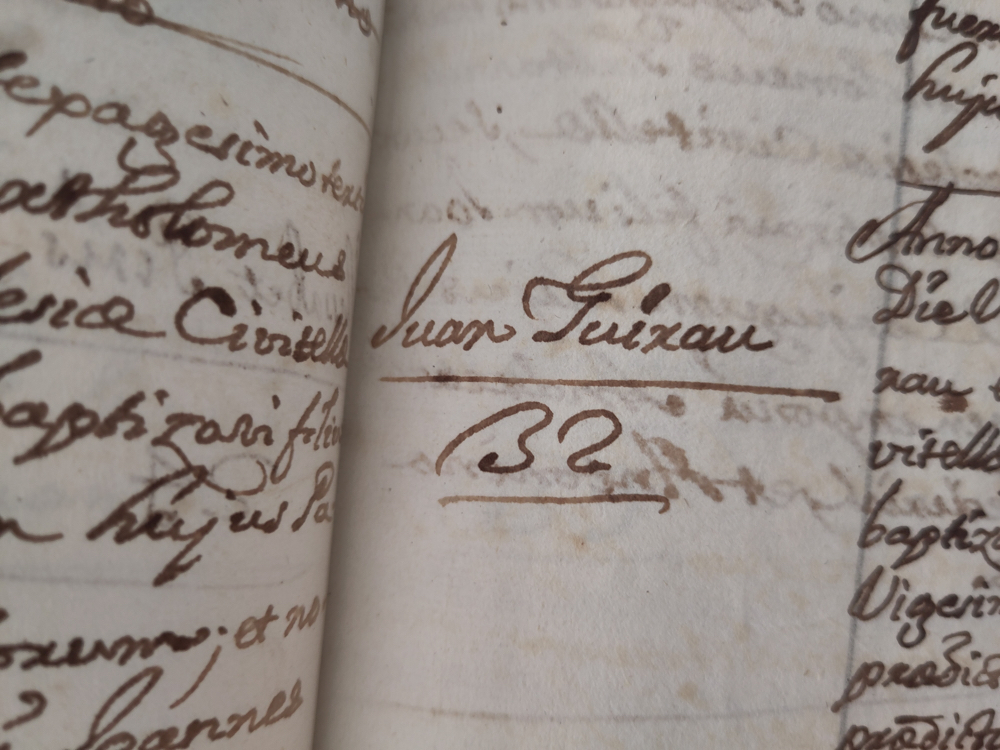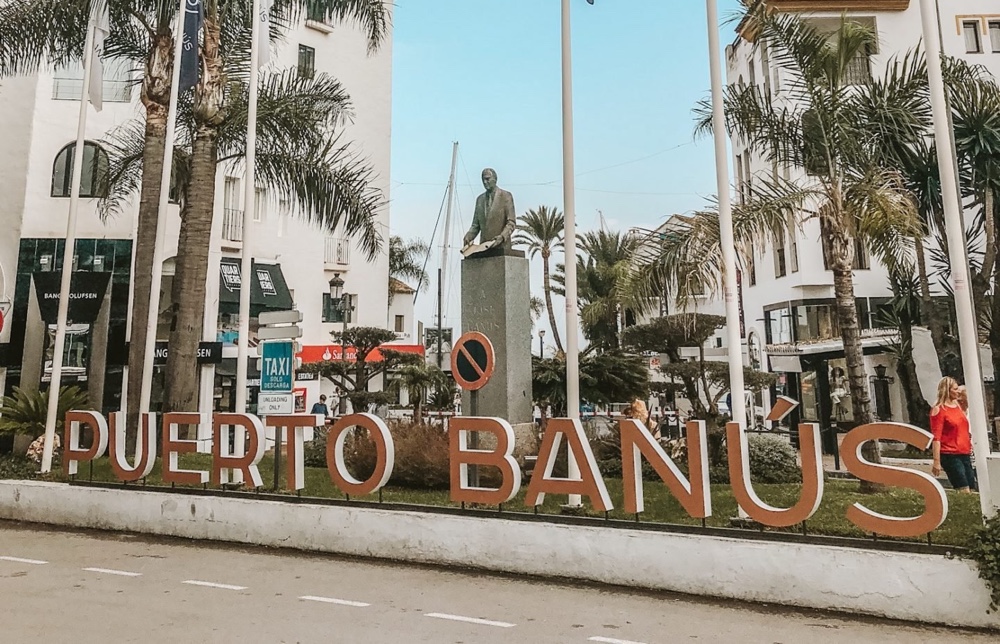The presence of Menorcans over a long time on the Rock has left some traces in the local street and placenames. But they often go unnoticed because they remain hidden in Upper Town, such as Tudury’s Steps, or buried in older forms or names from the past that have been replaced by new British names, such as the Seguí’s Passage (Lime Kiln Steps) and Cardona’s Steps (Paradise Ramp). The example that breaks the rule is Giro’s Passage, in the middle of Main Street and right in front of the façade of the church of St Mary the Crowned. Pretty much the heart of Gibraltar.
Although at first it might be suspected that it is a name linked to the large and significant Genoese community that began to arrive en masse in Gibraltar throughout the 18th Century, Giro does not appear in the list of Ligurian surnames present on the Rock that the late lamented Professor Fiorenzo Toso published in 2000. It could also be thought, as the researcher Richard Garcia did in his essential trilogy on the origin of the civilian population from 1704, that it is quite a good transcription of the French surname Giraud, which the priests and clerks working in Gibraltar in the 19th Century adapted phonetically, rendering it as ‘Giró’ or ‘Giro’, respectively. Furthermore, of course, it could also be a Menorcan family name transplanted to the Rock, as argued by Manolo Galliano in his monumental study on the place names of Gibraltar. In fact, the key lies somewhere between what Garcia and Galliano suggest.

In the section entitled “Giro’s Passage”, in the book A Rocky Labyrinth: The History of our Streets, Lanes, Roads and Ramps (2022), Galliano comments:
“The name first appears in the 1814 Register of Inhabitants when it is referred to as Giro’s Entrance and apparently became known as such in connection with properties owned in the area by a John Giro, an important local merchant, who had arrived on the Rock from Minorca in 1782. The archway entrance to Giro’s Passage has the peculiarity of displaying a corner stone with a frontal facing crowned lion’s face with flowing mane, carved in relief, with the date of 1751 engraved beneath.”
And in the third volume of In the shadow of the British fortress of Gibraltar (2021), Garcia explains: “The assignment of a property from Jacob de Abram Attias to ‘John Girau’ was approved in August 1794. The name was missed in the Civil Secretary’s Diary: he was described elsewhere in the Diary as John Girow or John Giro. The marriage records of St Mary the Crowned show that two years earlier ‘Juan Baptista Giró’ married Angela Maria Novella, who was born in Gibraltar. His father was French and came from Languedoc. This suggests that his original name was Jean Baptiste Giraud, and that he was Hispanicized by the priests to Juan Giró. The Civil Secretary’s Diary entry confirms how the name was pronounced.”
One of the great pleasures of sifting through historical archives and specialised bibliography is that, sometimes, pulling on the thread of a clue that at first glance may seem insignificant or trivial can suddenly lead to all kinds of curious and interesting stories that may even be unexpectedly linked to others. This happened to me with none other than the name of the passage which this article is about.
A Menorcan family on Main Street
The first documented appearance in Gibraltar of the Giró family is probably the entry found in the civilian census of 1791, where a 29-year-old Menorcan sawyer, Juan Gó [sic], who according to the official taking the census had been there for at least seven years. The second reference, contained in the marriage book kept in the Gibraltar parish archive, is much clearer: the Menorcan Joan Baptista Giró married a local girl, Angela Maria Morello, on 21 July 1792, according to the record. The document – written in Latin – reveals the name and origin of the groom’s parents: Juan Bautista Giró was from Languedoc and Magdalena Bonid [sic], from Menorca.
Although in Gibraltar we saw Juan Giró’s surname appear with all kinds of variants (Gó, Giró and Giro, Girau, Girow…), in his birthplace, Menorca, the to-and-fro of spellings is no less remarkable. One need look no further than the Book of Baptisms held in Ciutadella, where the same person is registered on 28 January 1763 as Joan Guirau. His parents, Joan Guirau and Magdalena Bonnín, had married some time between 1761 and 1763, as can be deduced from a report on the freedom to marry of foreigners and aliens dated 9 December 1760: “Joan Guiraud [sic ], legitimate and natural son of John, deceased, and Guillelma Robertina, living, native of Peyran [Peirens] and baptized in the parish of the same town of the diocese of St. Papoul [Saint Papule] of the province of Languedoc in France, seeks to marry Magdalena Bonnin y Piña, spinster, natural and legitimate daughter of Miguel, deceased, and Eleonor Piña of this parish of Ciutadella.”

Still with reference to the Menorcan church archives, in another report dated 18 November 1768, Joan Giraud [sic] himself states as a witness that he had arrived in Menorca with the French squadron during the occupation of the island in 1756, as part of the Vermandois regiment. It is clear, then, that like several other French soldiers, when Menorca returned to British hands in 1763, they decided to lay down arms and stay, taking up civilian jobs and even settling down with local women. But another conquest of the island, when the Spanish took it in 1782, seems to have pushed at least the first son he had with Magdalena, Joan Giró Bonnín, to look for work in Gibraltar, a fortress that was barely coming out of the Great Siege and was preparing for reconstruction and economic recovery at the turn of the century. As a result of his marriage on the Rock with Angela Maria Morello a decade later, the now settled sawyer had a fairly extensive family and, according to all the evidence, he entered the circle of the flourishing local commercial bourgeoisie of Gibraltar at the beginning of the 19th Century: “He became a principal merchant”, comments Richard Garcia, “and Giro’s Passage – opposite the Cathedral of St Mary the Crowned – is named after him. His house was on the north-east corner of Giro’s Passage facing the church.”
In fact, the first-born of the Giró-Morello couple, “Juan Enrique”, was baptized in the cathedral (so just a few steps away from the family home) on 14 February 1796 with the “consul d’Animarca” [sic, but no doubt the ‘consul de Dinamarca’ or Danish Consul], Enrique Linchi, as godfather. Later, this same young Gibraltarian with a Menorcan father and a grandfather from Languedoc chose to continue in business in the commercial sector and was, in fact, the one who gained a reputation as a great businessman in the family. He earned it, in fact, a little further to the north of Gibraltar, in Malaga, a city where he settled around 1825. Previously, as the art historian Julia de la Torre Fazio comments in an article in the Art Bulletin of the University of Málaga, he had spent time in Cádiz where, in 1824, he had married María Manuela de Aramburu Rodríguez, a rich woman of Peruvian origin.
Juan Giró, a Gibraltarian businessman in Malaga
With cash in his pocket and a nose for business opportunities, Juan Giró Morello (as he was known in Andalusia) was one of the founding partners of Ferrería La Concepción, an industrial establishment based on the English model located in the upper area of Marbella in 1826 which was supplied with minerals from two nearby open pit mines called, coincidentally, the Peñón and the Peñoncillo (‘the Rock’ and ‘the Little Rock’). Shortly afterwards he acquired a significant stake in the El Ángel Ironworks Company, located in the lower area of Marbella, one of the first properly operated civil blast furnaces on the Iberian Peninsula, and from at least 1841 he was its director. It was his decision, for example, to build an extension of El Ángel in Málaga on land in the district of La Malagueta.
In the Guía del Viajero en Málaga (1861), a travel guide, Benito Vilá said: “Mr. Juan Giró, from our business community, managed to give the work undertaken the vigorous impulse and the straight and constant progress that very soon produced the results naturally flowing towards a growing reputation, and today this establishment is one of the best of its kind in our country. The exquisite quality of its iron, due in large part to the assiduous attention with which it seeks to perfect its work, makes it highly prized in most of our consumer cities; furthermore, at the universal exhibitions recently held in London and Paris, medals and prizes have been awarded in recognition of the peerless quality of the El Ángel ironwork.”
It should be said that, in the 1840s, 72% of all Spanish foundry activity was concentrated in this small area of the Mediterranean coast. During those years of high industrial activity, Giró also had a share in the cotton textile company La Industria Malagueña, founded in 1846 by the Heredia and Larios families, and in 1851 he was part of the Lloyd’s of Málaga insurance company.

As a very notable character in Málaga (he became Commander of the Royal Order of Carlos III and founder and permanent member of the Academy of Fine Arts of San Telmo), the businessman of Gibraltarian origin acquired a property near La Malagueta in 1854 to build his private home, the “Hacienda Giró”, in a part of the city that, at least in terms of names, have an echo of his native Gibraltar: the Cañada de los Ingleses, next to the city’s historic Protestant cemetery, at the foot of Gibralfaro and with views of La Alameda and La Caleta beach. The sumptuous villa had large rooms and painted ceilings and housed one of the best art collections in Málaga, with works by Murillo, Titian, Mengs, Giordano and Ribera, as well as gardens held in high esteem by the local bourgeoisie adorned with marble fountains and even some notable 18th Century Italian statues acquired at an auction of materials recovered from a shipwreck on the coast of Benalmádena.
In December 1874, after the death of Juan Giró Morello from hypostatic ulcers in June 1872, shortly followed by that of his only son, Juan Giró Aramburu, from smallpox, his widow decided to sell the property in 1888. From then on it first became the Pensión Cooper boarding house; during the Spanish Civil War of 1936-1939 the building was occupied by Franco’s troops and the Condor Legion used it as a hospital; after the war it became the Belaire Hotel; and in 1959 it was converted into a religious school and a student residence for the Teresian Order of Nuns before being demolished in the 1970s. The former garden is now occupied by the sports facilities of the Almar Foundation and, of the original property, only the retaining wall that faces Paseo de Sancha and the historic Reding Fountain remain.

Epilogue.
It is worth mentioning a curious sequel to this story that had begun at the start of the 19th Century in the square in front of the Church of St Mary the Crowned in Gibraltar. A large urban development project, called Nueva Andalucía, was started under the 1963 Law of Centres and Areas of Tourist Interest on the land which had been the site of the El Ángel de Marbella ironworks in the 19th Century. This was carried out under a businessman loyal to the Francoist regime, Josep Banús i Masdeu (La Masó, 1906 – Madrid, 1984), who had just built the access roads to the Valle de Los Caídos (the Valley of the Fallen – now the Valle de Cuelgamuros) and who would also be a leading figure in the intense construction activity in the districts around Madrid. Thus was born, in 1970 in this particular district of Marbella, the most emblematic and luxurious marina on the Costa del Sol, Puerto Banús, presided over by a sculpture of its Catalan developer.

Translation by Brian Porro

Comments are closed